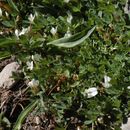Physical Description
provided by USDA PLANTS text
Perennial, Herbs, Stems woody below, or from woody crown or caudex, Plants with rhizomes or suckers, Taproot present, Nodules present, Stems prostrate, trailing, or mat forming, Stems less than 1 m tall, Stems solid, Stems or young twigs glabrous or sparsely glabrate, Stems or young twigs sparsely to densely hairy, Leaves alternate, Leaves petiolate, Stipules conspicuous, Stipules green, triangulate to lanceolate or foliaceous, Stipules persistent, Stipules clasping stem at the base, Stipules adnate to petiole, Leaves compound, Leaves palmately 2-3 foliate, Leaflets dentate or denticulate, Leaflets 3, Leaves glabrous or nearly so, Flowers solitary in axils, or appearing solitary, Flowers in axillary clusters or few-floweredracemes, 2-6 flowers, Inflorescences racemes, Inflorescences globose heads, capitate or subcapitat e, Inflorescence axillary, Bracteoles present, Flowers zygomorphic, Calyx 5-lobed, Calyx glabrous, Petals separate, Corolla papilionaceous, Petals clawed, Petals white, Petals blue, lavander to purple, or violet, Petals bicolored or with red, purple or yellow streaks or spots, Banner petal narrow or oblanceolate, Wing petals narrow, oblanceolate to oblong, Wing petals auriculate, Wing tips obtuse or rounded, Keel tips obtuse or rounded, not beaked, Stamens 9-10, Stamens diadelphous, 9 united, 1 free, Filaments glabrous, Style terete, Fruit a legume, Fruit unilocular, Fruit indehiscent, Fruit oblong or ellipsoidal, Fruit orbicular to subglobose, Fruit or valves persistent on stem, Fruit enclosed in calyx, Fruit glabrous or glabrate, Fruit 1-seeded, Fruit 2-seeded, Seeds cordiform, mit-shaped, notched at one end, Seed surface smooth, Seeds olive, brown, or black, Seed surface mottled or patchy.

